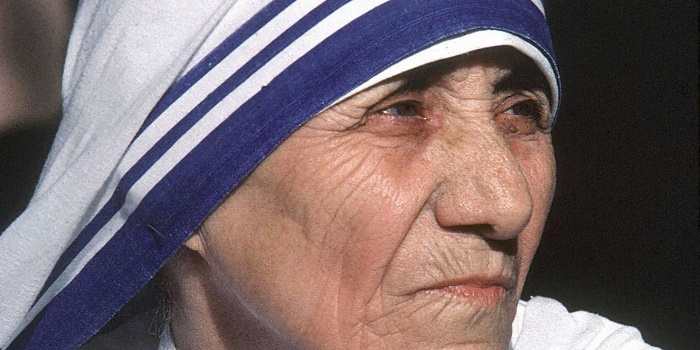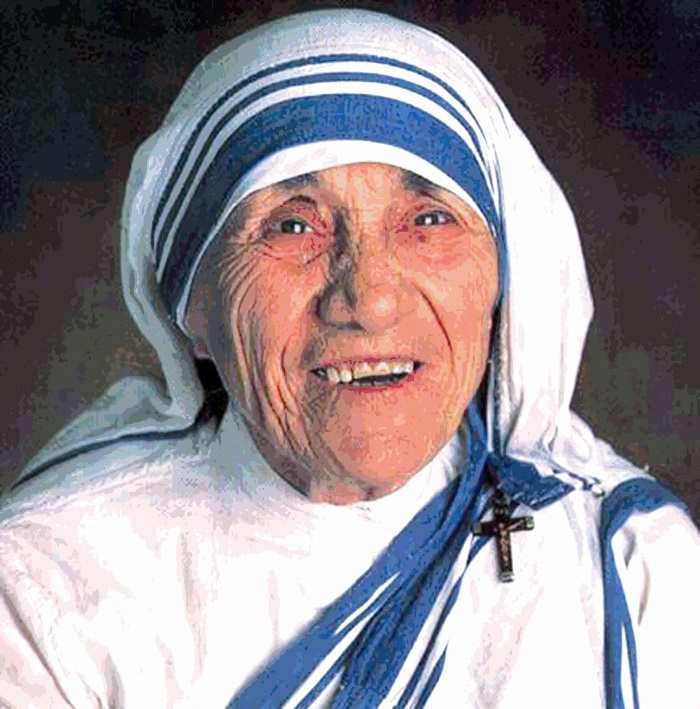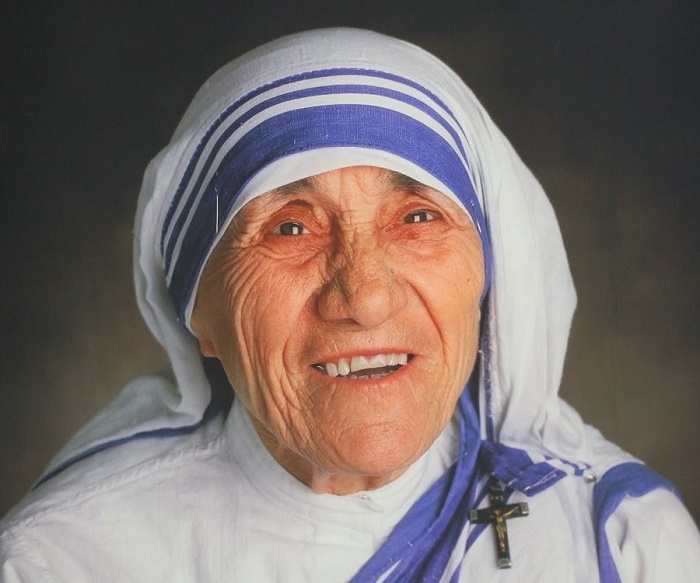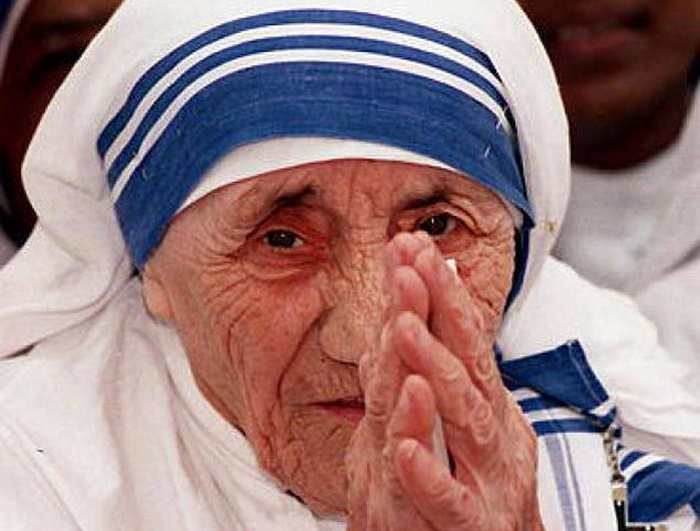Date of Birth: August 26, 1910
Place of Birth: Skopje, Ottoman Empire (currently Republic of Macedonia)
Parents: Nikola Bojaxhiu (Father) and Dranafile Bojaxhiu (Mother)
Institution: Missionaries of Charities
Religious Views: Roman Catholic
Death: September 5, 1997
Place of Death: Kolkata, West Bengal, India
Memorial: Memorial House of Mother Teresa, Skopje, Republic of Macedonia

Mother Teresa (1910-1997) was a Roman Catholic nun from the Republic of Macedonia who adopted India as her country of service. She dedicated her life in the service of the poor, ailing and the destitute through the Missionaries of Charities, an order of Roman Catholic nuns, in Kolkata, India. She had once said, “Love cannot remain by itself – it has no meaning. Love has to be put into action, and that action is service.” Her work transcended geo-political borders and she encompassed the whole of humanity in her healing embrace. Her work was recognised through numerous international and national awards and recognitions. She was canonised at a ceremony in St. Peter’s Square at the Vatican by Pope Francis on September 4, 2016 and came to be known as Saint Teresa of Calcutta.
Early Life
Mother Teresa was born as Anjezë (Agnes) Gonxha Bojaxhiu in Skopje, the then Ottoman Empire (now the capital of Republic of Macedonia), on August 26, 1910 in an Albanian family. She was the youngest in the family. Her father, Nikola Bojaxhiu worked as a construction contractor as well as a trader and her mother, Dranafile Bojaxhiu hailed from a village near Gjakova. The family was devout catholic and Agnes’s father was a strong proponent of Albanian independence. Nikolai fell ill and ultimately succumbed to his ailments in 1919 when Agnes was just eight-year-old. Agnes was particularly close to her mother, who was a deeply religious woman with deep commitment to charity.
From a very young age, Agnes was attracted to a monastic life. She began her education in a Convent-run school and joined the local Sacred Heart choir in her church. She had heard the stories of Catholic Missionaries and their work of serving humanity. By the age of 12, she strongly believed that it was the calling of her life. Her pilgrimages to various Catholic churches, especially the shrine of the Black Madonna of Vitina-Letnice, strengthened her beliefs and inclinations.

Induction into Monastic Life
In 1928, she left Skopje to join the Institute of the Blessed Virgin Mary, at Loreto Abbey in Rathfarnham, Ireland, a Catholic institution, which was popularly known as Sisters of Loreto. There, she was inducted into nunnery. She was given the name Sister Mary Teresa after the Saint Thérèse of Lisieux. After a training of around six months in Dublin, the capital of Ireland, Teresa was sent to Darjeeling, India to complete the novitiate period.
On 24 May, 1931 she took her initial vows as a nun, the First Profession of Vows. She was sent to Calcutta by the Sisterhood. For around next 15 years, Mother Teresa taught at St. Mary's High School in Calcutta, now Kolkata. The school run by the Sisters of Loreto provided free education to girls hailing from poor families. Here, Teresa became well versed in Bengali, and improved her English. She also became the principal of the school in 1944.
During her Final Profession of Vows on May 24, 1937, she took a vow of poverty, chastity and obedience. She took on the customary title of Mother and came to be known as Mother Teresa.

Call for Serving Humanity
Although Mother loved teaching and enjoyed shaping young minds at St. Mary’s, she was immensely disturbed by the plight of people around her. She was witness to the Bengal Famine in 1943, and experienced the pitiful condition of the poor during the trying times. Sufferings and desperation of the hungry tugged at the chords of her heart. The Hindu-Muslim Riots of 1946 prior to partition of India tore the nation apart. These two traumatic events drove Mother Teresa to contemplate what she could do to alleviate the sufferings of the people around her.
On 10 September, 1946, while traveling to Darjeeling, North-Bengal, for the annual retreat of the Convent, Mother heard "the call within call". She felt as if the Jesus was asking her to come out of the walls and serve the down-trodden of the society. Following the Call, on August 17, 1947, Mother left the Convent. Out of reverence towards the Indian culture she adopted white sari with a blue border. He applied for Indian Citizenship and took basic medical training from Holy Family Hospital in Patna. For the next few years, Mother Teresa lived among the poor, in the slums of Calcutta. She, along with a few fellow nuns, went door to door, begging for food and financial help. They survived on the bare minimum and used the excess to help people around them. Gradually, her tireless efforts were recognised and help started pouring in from various sources.

Missionaries of Charity
The Missionaries of Charity came into being on October 7, 1950, in Calcutta with the Vatican decree recognising the diocesan congregation. Mother Teresa and her Missionaries of Charity proceeded with a singular aim to care for "the hungry, the naked, the homeless, the crippled, the blind, the lepers, all those people who feel unwanted, unloved, uncared for throughout society, people that have become a burden to the society and are shunned by everyone", more succinctly the poorest of the poor among the society.
She opened the Nirmal Hriday (The Home of the Pure Heart) at Kalighat in 1952, a hospice for the dying. Individuals brought in were given medical attention, dignity before death with the knowledge that someone cares and appropriate last rites after death. She next opened Shanti Nagar, a home for those ailing with leprosy, and shunned by the society, along with several outreach clinics attending to the patients. She also established the Nirmal Shishu Bhavan or Children's Home of the Immaculate Heart, in 1955, an orphanage for children. By the 1960s, the Missionaries of Charity expanded its operations throughout India.
In 1965, the Pope Paul VI granted a Decree of Praise and allowed Mother Teresa to expand her congregation to other countries. Now, the Society became an International Religious Family. Following the decree, the Missionaries of Charity expanded their work to many countries around the world starting from Venezuela and included several countries in East Africa, North Europe and South America.
To strengthen the organization and spread the message of international brotherhood, Mother Teresa opened a few more organisations. She founded the Missionaries of Charity for brothers in 1963, Contemplative Branch of Sisters in 1976 and Contemplative Branch of Brothers in 1979, subsequently.
Today, The Missionaries of Charity consists of over 4,000 nuns. The organization, so far, has expanded its wings to over 100 countries. The objective of the Missionaries of Charity is to provide care and support to the sick, mentally ill, aged, victims of incorrigible diseases, and abandoned children. The Missionaries of Charity has opened around 20 homes in Calcutta including a school for street children.

Death
After 1980, Mother Teresa suffered some serious health problems including two cardiac arrests. Despite her health problems, Mother kept governing the Missionaries of Charity and its branches, as efficiently as earlier. In April 1996, Mother Teresa fell and broke her collar bone. Thereafter, Mother's health started declining and on September 5, 1997, she left for the heavenly abode.
Awards and Recognitions
Mother Teresa believed in the good of Humanity. She believed “Not all of us can do great things. But we can do small things with great love.” And that message became the basis of her life’s work. She worked tirelessly, tending to the ailing, teaching the children and speaking to the topmost tier of the society of her vision. Mother Teresa not only built a giant institution and gave it the vision but also inspired millions of people around the globe to do their bit.
She received numerous awards and recognitions for her endeavours. She received the Padma Shree in 1962 and the Bharat Ratna in 1980. She was awarded the Ramon Magsaysay Award for Peace and International Understanding in 1962 for her work in South East Asia. She accepted the Nobel Peace Prize in 1979 but refused to attend the ceremonial banquets and requested the authorities to donate the expenses to charity. She was honoured with a number of civilian recognitions in other countries like the UK, the US, Australia and Germany. The Roman Catholic Church recognised her voluminous work with the first ‘Pope John XXIII Peace Prize’ in 1979.
Controversies
Mother’s efforts received criticism from certain human rights agencies once she vocally expressed her views against contraception and abortion. Some allegations were made against her hospices for not providing proper pain alleviating methods or medical attentions to the dying despite receiving millions of dollars in donation for that specific purpose.
Canonization
Following her death, the process of beatification was initiated by Pope John Paul II. The process requires the documentation of a miracle performed by the prospective saint. The Vatican recognised the case of Monica Besra; her abdominal tumour was cured by a locket containing Mother Teresa’s image. In 2002, Pope John Paul II confirmed the decrees to Mother's canonization. On 19 October, 2003 the Pope beatified the Mother before a huge crowd at St. Peter's square, Vatican City. The second miracle of healing a Brazilian man with brain tumour was accepted by the Vatican in 2015. Following this recognition, Pope Francis canonised Mother Teresa in a ceremony at St. Peter’s Square on September 4, 2016 and she came to be known as ‘Saint Teresa of Calcutta’.



